Strategic Review of Innovation in the Payments System: Results of the Reserve Bank of Australia's 2010 Consumer Payments Use Study – June 2011 5. The Use of Online and Newer Payment Methods
The 2010 Study in part focuses on newer payment methods, which are of interest for the Bank's Strategic Review of Innovation in the Payments System. As noted in Section 3, online payments are becoming an increasingly important part of the Australian payments landscape and now account for 7 per cent of consumer payments and around one-quarter of the value of payments. This section discusses some of the more detailed data collected on online payments, including information on areas that may be constraining further uptake of this channel. It also provides some early data on two of the emerging payment methods – contactless cards and mobile payments.
Online Payments
The adoption of online payments is quite high in Australia. The 2010 Study suggests that around 90 per cent of Australians have internet access at home or work. Of those, about 80 per cent have made a purchase online and almost 60 per cent have made online transfers to a family member or friend. Just over 60 per cent of people with internet access pay most of their bills online.
Consumers have several methods with which they can make payments online, including: credit card; scheme debit card; BPAY; internet-banking transfers; and the specialised online payment schemes of Paymate, PayPal and POLi. It should be noted, however, that not all these methods are suitable for all types of payments; for example, BPAY is largely used for bill payments. In addition, merchants may not accept all these forms of online payments.
Age is an important factor affecting whether payments are made online. Payments made online account for around 10 per cent of all payments for people aged under 40, compared to around 3 per cent for people aged 60 and above (Graph 20). This may reflect differences in shopping preferences between age groups, as well as younger people potentially being more comfortable with making online payments.
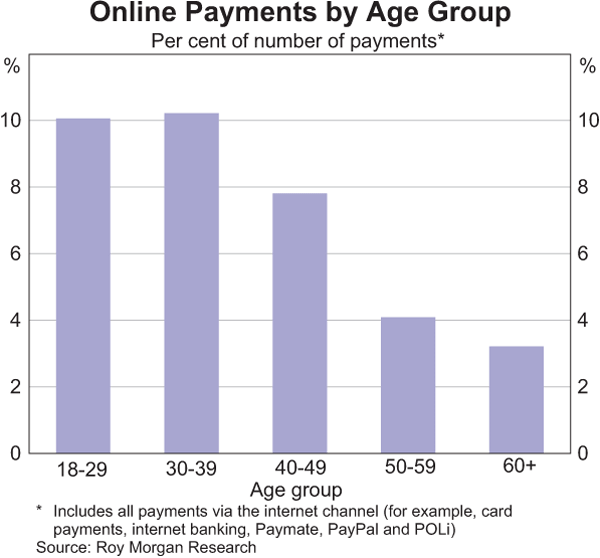
Around half of online payments are made to pay household bills (Graph 21). The bulk of the remainder fall into the ‘other’, ‘other retailer’, leisure, holiday travel and services merchant categories.
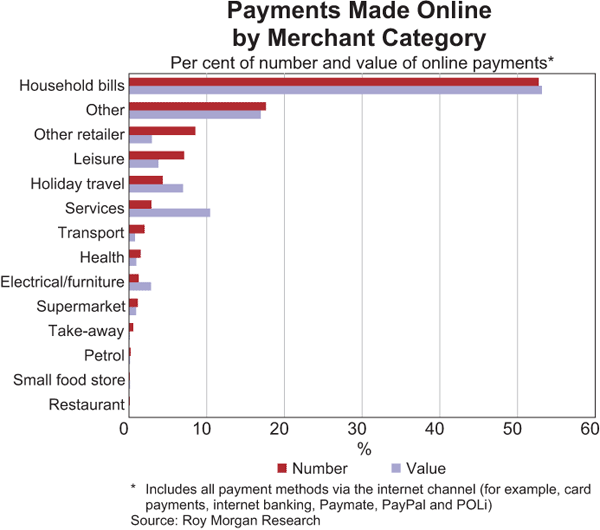
Major deterrents to the use of online payments
As part of the end-of-study questionnaire, participants were asked to indicate the various factors that would increase their use of online bill payments, purchases and transfers.[14] They were initially asked to identify all the factors that are important to them and then the single most important factor. These questions were aimed at providing a perspective on perceived gaps in the services that online payments offer.
The results of the end-of-study questionnaire indicate that a substantial proportion of people are perfectly satisfied with current online payment methods and do not believe there are factors that would lead them to increase their use of these methods. This is true of around 40 per cent of people for online bill payments and funds transfers to friends or family (Graphs 22 and 23). This may be a reflection of a degree of comfort with internet banking based payment options, such as BPAY for bill payments and ‘pay anyone’ arrangements for transfers. A smaller proportion (31 per cent) are perfectly satisfied with the way they can make online purchases, for which credit and scheme debit cards, and PayPal are more typically used (Graph 24).
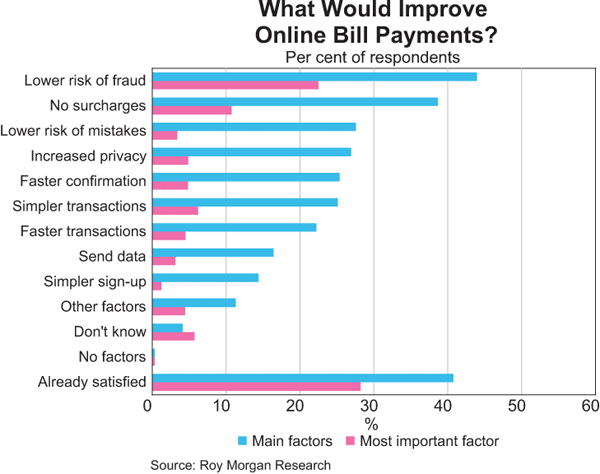
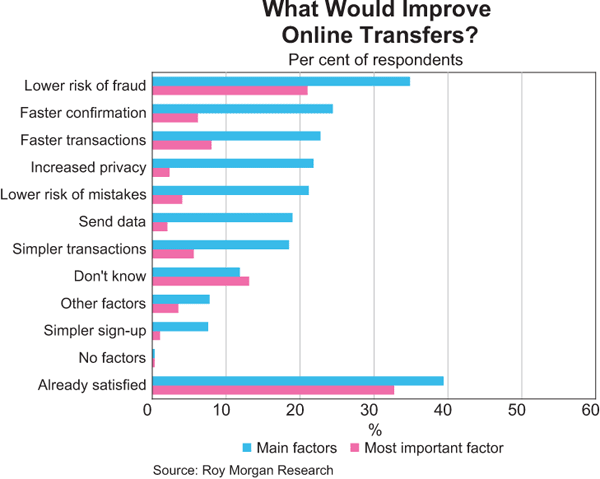
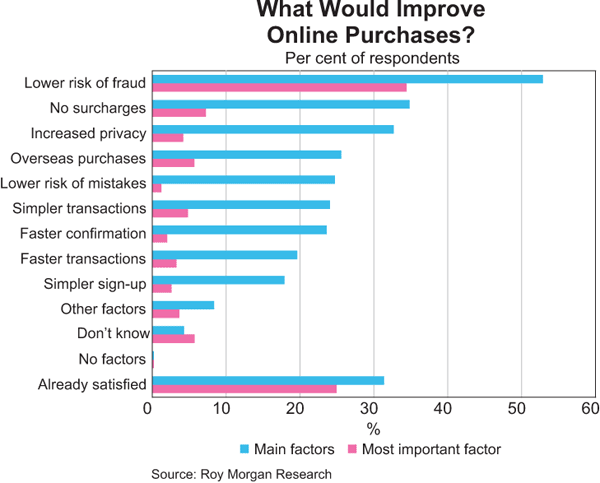
By far the biggest deterrent to making any type of payment online is the risk of fraud. This concern is higher for online purchases than for bill payments and transfers, again possibly reflecting the fact that consumers tend to feel most secure making payments online when they can be made through their financial institution's internet-banking site, although the degree of trust in the payee might also be a factor.[15]
The major deterrents to the use (or further use) of online payments are similar, regardless of whether the consumer is a frequent or infrequent user of online payments. In either case, fraud risk is the biggest concern. The need for increased privacy is also viewed as being a quite important impediment across all payment types for consumers who do not make many payments online. Therefore, overall, the results are suggestive of some need for further security innovation in the online payments market.
Other factors affecting the use of online payments
Other factors that affect consumers' use of online payments are quite specific to the different types of payments that can be made online. A significant deterrent to the increased use of online methods for bill payments (though much less important than fraud risk) is the presence of surcharges. Around 39 per cent of people identified surcharges as being a factor that deters use and 11 per cent of people identified it as the most important factor. For personal transfers, a lack of transaction speed and the speed of confirmation were seen as more significant impediments than for other types of online payments. Around 30 per cent of respondents who had made an online transfer indicated that improvements along one of these dimensions would increase their preference for online payments.
There are some factors that may have been expected to be important to consumers but were not identified as being significant impediments to online payments. For example, the ability to transmit additional data or information with a payment, which has been a concern for business, does not stand out as a factor constraining consumers' use of online payments, although consumers with experience of online transfers were somewhat more concerned with this issue (25 per cent).[16] Factors related to ease of use were also relatively minor concerns for both respondents with and without experience of making online payments. To the extent that they were rated as important by some consumers, factors such as simpler sign-up and simpler transactions appear to be much less important for online transfers than for bill payments and online purchases, possibly reflecting a high level of comfort with the setup of internet-banking sites.
Contactless Payments
Contactless card payments require the consumer only to hold their card in close proximity to, or to touch the card against, the terminal and do not require a PIN or signature for the transaction. While the roll-out of contactless cards has accelerated in recent years, at the time of the 2010 Study contactless payments were still not being widely used. Indeed, just 3 per cent of respondents indicated they had made a contactless payment in the month prior to the study. This most likely reflects the limited availability of, or education about, contactless functionality, with less than 8 per cent of respondents indicating that they held a contactless MasterCard/Visa credit or debit card and relatively limited availability of contactless terminals at the time.
Nonetheless, consumers appear to be willing to use the technology if they are aware of it. Of those who stated they held a contactless card, 39 per cent had made a contactless payment in the month prior to the study. The frequency of use by cardholders was modest though, with two-thirds of users making three or fewer contactless payments during that period. Usage was also concentrated in urban areas, with 72 per cent of users living in a capital city.
It is unclear whether contactless payments are primarily being substituted for cash or card payments. Although contactless functionality is largely targeted at cash replacement, the relatively high payment values recorded for contactless payments in the study suggest that they may be primarily replacing more standard debit and credit card transactions at the point of sale. Specifically, more than two-thirds of respondents indicated that their average contactless payment was over $20 – well above the median cash payment of $12 (Graph 25).
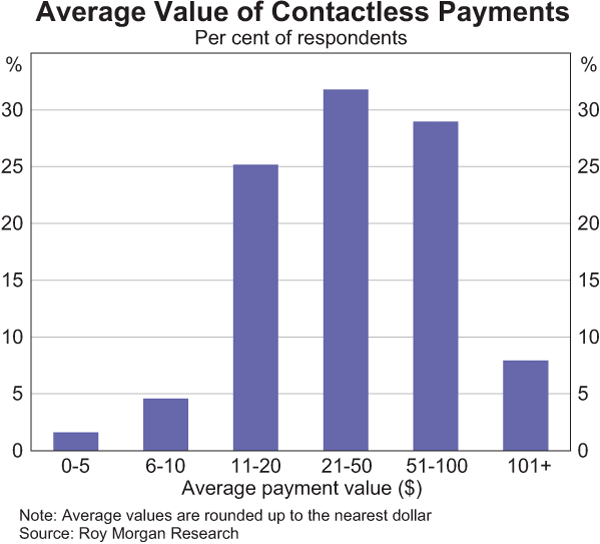
The responses suggest that contactless technology has the potential to be more widely used by consumers in the future. Indeed, contactless payments appear to possess many of the characteristics that consumers like in cash. For example, around half of respondents indicated that the speed of processing – a prominent feature of contactless payments – was an important factor in their choice of payment method at the point of sale (Graph 4).
However, there are also some important characteristics of cash at the point of sale that are not possessed by contactless cards. For example, around 15 per cent of respondents stated that privacy influenced their choice of payment method at the point of sale. For these individuals, cash may be preferred over contactless payments because of its anonymity.
Mobile Payments
Despite very high penetration of mobile phones in Australia (91 per cent of respondents), adoption of mobile payments is modest. Only around 10 per cent of people with a mobile phone have made a mobile payment at any stage. Usage of mobile payments also appears to be primarily for phone-related services and products, with about 60 per cent of users buying ring-tones, games or applications (‘apps’) for their phones (Graph 26). Most of the remaining use seems to be internet payments made via mobile phone, for example personal transfers using internet banking (43 per cent of mobile payments users), bill payments (40 per cent) and online purchases (32 per cent).
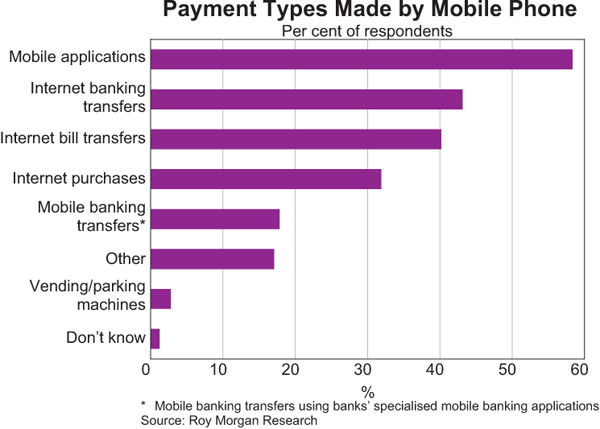
An important influence on mobile payments usage is age, with younger people more likely to make a payment using their mobile phone. About 20 per cent of people aged between 18 and 29 years have made a mobile payment, compared with less than one per cent of people aged 60 years or over (Graph 27).
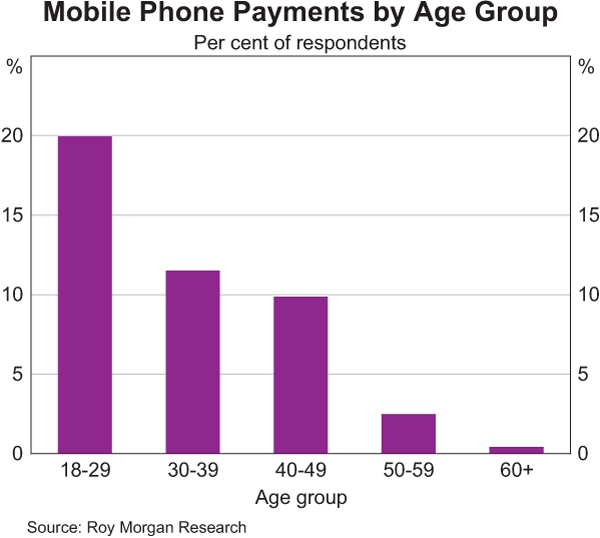
Footnotes
For online bill payments, if consumers indicated that they paid most of their bills online, they were asked ‘What factors would most improve your experience of paying those bills online?’ or if they indicated that they did not pay most of their bills online, ‘What factors would make you pay more of your bills online?’ For online purchases, consumers were asked ‘What factors would make you more likely than currently to pay for goods or services online?’ For online transfers, consumers were asked ‘What factors would make you more likely than currently to transfer money over the internet to a friend or family member?’ [14]
BPAY payments can be made via a bank's internet-banking site, phone-banking service or mobile payments service. The diary results suggest that around 77 per cent of BPAY payments are made via internet banking. [15]
Currently, internet-banking transfers only allow consumers to enter a maximum of 18 characters of text to describe a payment. [16]